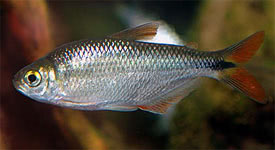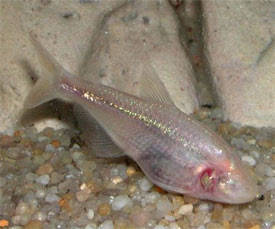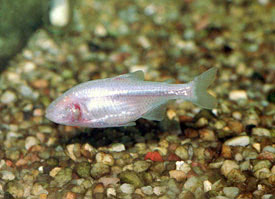
 Magyarul / Hungarian
Magyarul / Hungarian




- Scientific name: Astyanax mexicanus
- Synonyms: Astyanax argentatus, Astyanax fasciatus mexicanus, Tetragonopterus brevimanus, Tetragonopterus fulgens, Tetragonopterus mexicanus, Tetragonopterus nitidus, Tetragonopterus petenensis, Tetragonopterus streetsii
- Common name: Mexican tetra
- Group: Characins
- Habitat: Central America; Mexico, southern United States and Guatemala
- Size: 6-8 cm
- Biotope: Cave form in underground waters of Mexico; surface form widespread in from Texas to Panama.
- Social behavior: Peaceful, schooling species recommended for all community tanks. It sometimes nips at tankmates when feeding.
- Diet: Omnivorous, Will accept most foods including pellets and flake as well as live/frozen foods such as bloodworm and brine shrimp.
- Breeding: Relatively easy
- Tank: Minimum 80 litres
- Population: 4-5 fishes for 80 litres
- Decoration: An undemanding fish, the Mexican tetra can be readily kept in most tanks. Does not require special light levels and will not touch plants.
- Temperature: 20-24 °C
- pH: 6-8
- Hardness: 8-12 NK°
- Lifespan: 5-6 years
Description: The shape of the Blind cavefish is small, elongated, fairly flatsided, with a profile curved equally above and below. Adipose fin present. The color of the surface form is silvery to light brassy sheen on sides, with olive back. The tail and lower fins of some individuals may be tinted yellow or red. The cave form: monotone pink tint with a silver sheen. The eyes are completely burried beneath the skin. Both forms of the Mexican tetra have a forked tail, a small dorsal fin, and an anal fin that, on breeding males, possesses tiny hooks. The blind cavefish catch food by scent. It needs to be kept in a good shoal to avoid it nipping at other tank mates. Keep at least five and preferably more. They are fast swimmers and good-nature fish, which get on well with other fish species and leave smaller fish alone.
Females tend to be larger and fuller-bodied than males, and the anal fin of the male has a slightly curved edge. Relatively easy to breed in a 30-40 litres aquarium with water temperature of 18-20 °C. They are egg scatters. A layer of mesh should be added above the tank base in order to prevent predation of the eggs by the adults. They usually spawn in the morning. The parents should be removed from the aquarium after the spawning. The eggs are very sensitive. The eggs hatch quickly, within 3 or 4 days and the fry swim freely from the sixth day. Feed on live food: Artemia and very fine flakes.




